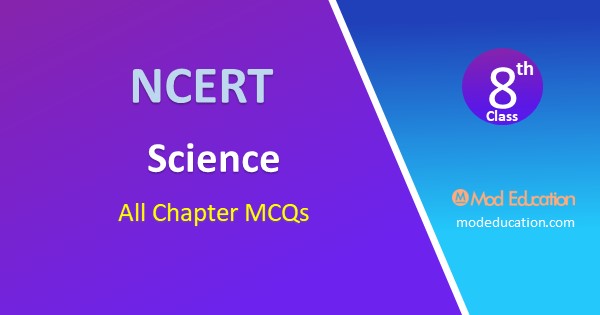MCQ Questions for Class 8 Science Chapter 9 : NCERT CBSE RBSE other Board MCQ Questions for Class 8 Science Chapter 9 Reproduction in Animals with Answers Pdf free download. MCQ Questions for Class 8 Science with Answers were prepared based on the latest exam pattern.

MCQ Questions for Class 8 Science Chapter 9 Reproduction in Animals with Answers
1. Human Male germ cell is
a) zygote
b) ovum
c) testis
d) sperm
Answer: (d)
2. Every month ____ mature egg(s) can be released from human ovary
a) 1
b) 2
c) 3
d) 4
Answer: (a)
3. Internal fertilization does not occur in
a) human
b) dog
c) fish
d) cow
Answer: (c)
4. Fertilization results into formation of
a) egg
b) zygote
c) sperm
d) individual
Answer: (b)
5. Which one is not an oviparous animal?
a) human
b) crow
c) hen
d) crocodile
Answer: (a)
6. The transformation of the larva into an adult through drastic changes is called
a) Metaphase
b) Metastasis
c) Meteorite
d) Metamorphosis
Answer: (d)
7. In asexual reproduction involves _______
a) Two parents
b) Four parents
c) One parent
d) No parents
Answer: (c)
8. Dolly the famous animal was a
a) donkey
b) girl
c) Cloned sheep
d) Normal sheep
Answer: (c)
9. During a cell division
a) Nucleus divides first and then cytoplasm
b) Cytoplasm divides first and then Nucleus
c) Nucleus and cytoplasm divides together
d) No such relationship
Answer: (a)
10. Budding is found in
a) Yeast
b) Hydra and Yeast
c) Hydra
d) None
Answer: (b)
11. The fusion of sperm and ova usually occur in the
(a) ovary
(b) uterus
(c) testes
(d) oviduct
Answer: (d) oviduct
12. Sets of reproductive terms are given below. Choose the set that has an incorrect combination.
(a) Sperm, testis, sperm duct, penis
(b) Menstruation, egg, oviduct, uterus
(c) Sperm, oviduct, egg, uterus
(d) Ovulation, egg, oviduct, uterus
Answer: (c) Sperm, oviduct, egg, uterus
13. Which of the following shows external fertilisation?
(a) Frog
(b) Human being
(c) Cow
(d) Hen
Answer: (a) Frog
14. Which one of the following is not a part of female reproductive organs?
(a) Uterus
(b) Ovary
(c) Oviduct
(d) Penis
Answer: (d) Penis
15. In the list of animals given below, hen is the odd one out.
‘human being, cow, dog, hen’
The reason for this is
(a) it undergoes internal fertilisation
(b) it is oviparous
(c) it is viviparous
(d) it undergoes external fertilisation
Answer: (b) it is oviparous
16. Animals exhibiting external fertilisation produce a large number of gametes. Pick the appropriate reason from the following
(a) The animals are small in size and want to produce more offsprings.
(b) Food is available in plenty in water.
(c) To ensure better chance of fertilisation.
(d) Water promotes production of large number of gametes.
Answer: (c) To ensure better chance of fertilisation.
17. Which is not a viviparous animal?
(a) Human being
(b) Cow
(c) Dog
(d) Butterfly
Answer: (d) Butterfly
18. Budding occurs in
(a) Amoeba
(b) dog
(c) Paramecium
(d) yeast
Answer: (d) yeast
19. The female gamete is called
(a) ova
(b) sperm
(c) zygote
(d) uterus
Answer: (a) ova
20. The male gamete is called
(a) sperm
(b) ova
(c) embryo
(d) zygote
Answer: (a) sperm
Match the items given in column I suitably with those given in column II.
| Column I | Column II |
| 1. Fission of male and female gametes | (a) Frog |
| 2. External fertilisation | (b) Fertilisation |
| 3. Female gametes | (c) Lay eggs |
| 4. Oviparous | (d) Asexual reproduction |
| 5. Single parent | (e) Ovum |
| 6. Main female reproductive organ | (f) Sperm |
| 7. Amoeba | (g) Ovary |
| 8. Yeast | (h) Binary fission |
| 9. Cloned sheep | (i) Budding |
| 10. Testes | (j) Dolly |
Answer:
| Column I | Column II |
| 1. Fission of male and female gametes | (b) Fertilisation |
| 2. External fertilisation | (a) Frog |
| 3. Female gametes | (e) Ovum |
| 4. Oviparous | (c) Lay eggs |
| 5. Single parent | (d) Asexual reproduction |
| 6. Main female reproductive organ | (g) Ovary |
| 7. Amoeba | (h) Binary fission |
| 8. Yeast | (i) Budding |
| 9. Cloned sheep | (j) Dolly |
| 10. Testes | (f) Sperm |
Match the items given in column I suitably with those given in column II.
| Column I | Column II |
| 1. Fission of male and female gametes | (a) Frog |
| 2. External fertilisation | (b) Fertilisation |
| 3. Female gametes | (c) Lay eggs |
| 4. Oviparous | (d) Asexual reproduction |
| 5. Single parent | (e) Ovum |
| 6. Main female reproductive organ | (f) Sperm |
| 7. Amoeba | (g) Ovary |
| 8. Yeast | (h) Binary fission |
| 9. Cloned sheep | (i) Budding |
| 10. Testes | (j) Dolly |
Answer:
| Column I | Column II |
| 1. Fission of male and female gametes | (b) Fertilisation |
| 2. External fertilisation | (a) Frog |
| 3. Female gametes | (e) Ovum |
| 4. Oviparous | (c) Lay eggs |
| 5. Single parent | (d) Asexual reproduction |
| 6. Main female reproductive organ | (g) Ovary |
| 7. Amoeba | (h) Binary fission |
| 8. Yeast | (i) Budding |
| 9. Cloned sheep | (j) Dolly |
| 10. Testes | (f) Sperm |
